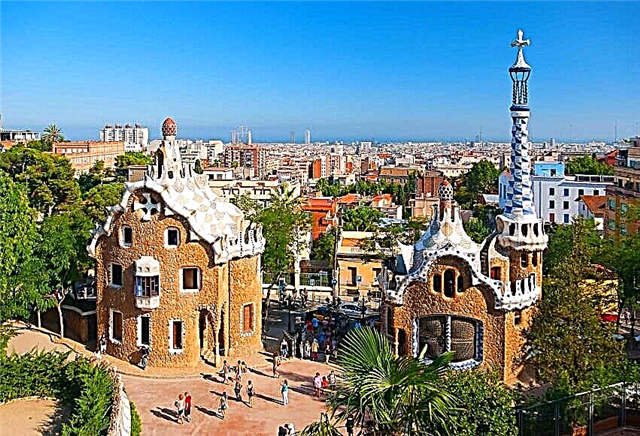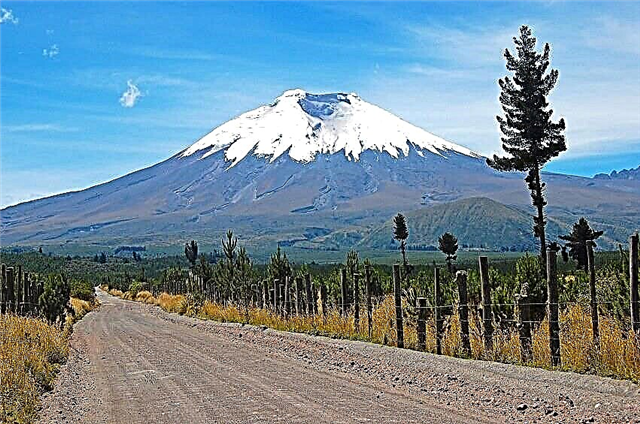The Mariana Trench (or Mariana Trench) is the deepest place on the earth's surface. It is located on the western edge of the Pacific Ocean, 200 kilometers east of the Mariana Archipelago.
Paradoxically, humanity knows much more about the secrets of space or mountain peaks than about the ocean depths. And one of the most mysterious and unexplored places on our planet is the Mariana Trench. So what do we know about him?
Mariana Trench - the bottom of the world
In 1875, the crew of the British corvette Challenger discovered a place in the Pacific Ocean where there was no bottom. Kilometer by kilometer the lot's rope went overboard, but there was no bottom! And only at a depth of 8184 meters the descent of the rope stopped. This is how the deepest underwater crack on Earth was opened. It was named the Mariana Trench after the nearby islands. Was determined its shape (in the form of a crescent) and the location of the deepest site, called the "Challenger Abyss". It is located 340 km south of the island of Guam and has coordinates 11 ° 22 ′ s. lat., 142 ° 35 ′ east etc.
Since then, this deep-sea depression has been called the "fourth pole", "the womb of Gaia", "the bottom of the world". Oceanographers have long tried to find out its true depth. Research over the years has given different meanings. The fact is that at such a colossal depth, the density of water increases as it approaches the bottom, therefore the properties of sound from the echo sounder in it also change. Using together with echo sounders barometers and thermometers at different levels, in 2011 the depth value in the "Challenger's Abyss" was set to 10994 ± 40 meters. This is the height of Mount Everest plus another two kilometers from above.
The pressure at the bottom of the underwater crevice is almost 1100 atmospheres, or 108.6 MPa. Most of the deep-sea vehicles are designed for a maximum depth of 6-7 thousand meters. During the time that has passed since the discovery of the deepest canyon, it was possible to successfully reach its bottom only four times.
In 1960, the deep-sea bathyscaphe Trieste for the first time in the world descended to the very bottom of the Mariana Trench in the Challenger Abyss with two passengers on board: US Navy Lieutenant Don Walsh and Swiss oceanographer Jacques Picard.
Their observations led to an important conclusion about the presence of life at the bottom of the canyon. The discovery of an upward flow of water also had an important ecological significance: based on it, the nuclear powers refused to dump radioactive waste at the bottom of the Mariana Gap.
In the 90s, the Japanese unmanned probe "Kaiko" examined the gutter, which brought from the bottom samples of sludge, in which bacteria, worms, shrimps, as well as pictures of a hitherto unknown world were found.
In 2009, the American robot Nereus conquered the abyss, lifting samples of silt, minerals, samples of deep-sea fauna and photos of inhabitants of unknown depths from the bottom.
In 2012, James Cameron, the author of Titanic, Terminator and Avatar, dived into the abyss alone. He spent 6 hours at the bottom collecting samples of soil, minerals, fauna, as well as taking photographs and 3D video filming. Based on this material, the film "Challenge to the Abyss" was created.
Amazing discoveries
In the trench, at a depth of about 4 kilometers, there is the active Daikoku volcano, spewing out liquid sulfur, which boils at 187 ° C in a small depression. The only lake of liquid sulfur was discovered only on the moon of Jupiter - Io.
In 2 kilometers from the surface "black smokers" swirl - sources of geothermal water with hydrogen sulphide and other substances, which, in contact with cold water, turn into black sulphides. The movement of sulphide water resembles a plume of black smoke. The water temperature at the point of discharge reaches 450 ° C. The surrounding sea does not boil only because of the density of the water (150 times higher than at the surface).
In the north of the canyon, there are "white smokers" - geysers that spew liquid carbon dioxide at temperatures of 70-80 ° C. Scientists suggest that it is in such geothermal "boilers" that one should look for the origins of life on Earth. Hot springs "warm up" the icy waters, supporting life in the abyss - the temperature at the bottom of the Mariana Trench is in the range of 1-3 ° C.
Life outside of life
It would seem that in an atmosphere of complete darkness, silence, icy coldness and unbearable pressure, life in the depression is simply unthinkable. But studies of the depression prove the opposite: there are living things almost 11 kilometers under the water!
The bottom of the hole is covered with a thick layer of mucus from organic sediments that have been descending from the upper layers of the ocean for hundreds of thousands of years. Mucus is an excellent breeding ground for barrophilic bacteria, which form the basis of nutrition for protozoa and multicellular organisms. Bacteria, in turn, become food for more complex organisms.
The ecosystem of the underwater canyon is truly unique. Living things have managed to adapt to an aggressive, destructive environment under normal conditions, under high pressure, lack of light, a small amount of oxygen and a high concentration of toxic substances. Living in such unbearable conditions has given many of the inhabitants of the abyss a frightening and unattractive look.
Deep-sea fish have an incredible mouth, seated with sharp long teeth. The high pressure made their bodies small (2 to 30 cm). However, there are also large specimens, such as the amoeba-xenophyophora, reaching 10 cm in diameter. Frilled shark and goblin shark, living at a depth of 2000 meters, generally reach 5-6 meters in length.
Representatives of different types of living organisms live at different depths. The deeper the inhabitants of the abyss, the better their visual organs are developed, allowing them to catch the slightest reflection of light on the body of prey in complete darkness. Some individuals themselves are capable of producing directional light. Other creatures are completely devoid of organs of sight, they are replaced by organs of touch and radar. With increasing depth, underwater inhabitants lose their color more and more, the bodies of many of them are almost transparent.
On the slopes where the "black smokers" live, mollusks live, which have learned to neutralize sulphides and hydrogen sulfide, which are lethal for them. And, which still remains a mystery to scientists, in the conditions of tremendous pressure at the bottom, they somehow miraculously manage to keep their mineral shell intact. Other residents of the Mariana Trench show similar abilities. The study of fauna samples showed a multiple excess of the level of radiation and toxic substances.
Unfortunately, deep sea creatures die due to pressure changes in any attempt to bring them to the surface. Only thanks to modern deep-sea vehicles has it become possible to study the inhabitants of the depression in their natural environment. Representatives of the fauna that are not known to science have already been identified.
Secrets and mysteries of the "womb of Gaia"
A mysterious abyss, like any unknown phenomenon, is shrouded in a mass of secrets and mysteries. What does she hide in her depths? Japanese scientists claimed that while feeding goblin sharks, they saw a shark 25 meters long devouring goblins. A monster of this size could only be a megalodon shark, which became extinct almost 2 million years ago! This is confirmed by the finds of megalodon teeth in the vicinity of the Mariana Trench, whose age dates back only 11 thousand years. It can be assumed that specimens of these monsters are still preserved in the depths of the hole.
There are many stories about the corpses of giant monsters thrown ashore. While descending into the abyss of the German submarine "Highfish", the dive stopped 7 km from the surface. To understand the reason, the passengers of the capsule turned on the lights and were horrified: their bathyscaphe, like a nut, was trying to gnaw at some prehistoric lizard! Only a pulse of electric current through the outer skin was able to scare away the monster.
Another time, when an American submersible was submerged, the grinding of metal began to be heard from under the water. The descent was stopped. Upon examination of the lifted equipment, it turned out that the titanium alloy metal cable was half sawn (or gnawed), and the beams of the underwater vehicle were bent.
In 2012, a video camera of the unmanned aerial vehicle "Titan" from a depth of 10 kilometers transmitted an image of objects made of metal, presumably a UFO. Soon the connection with the device was interrupted.
We advise you to read about Halong Bay.
Unfortunately, there is no documentary evidence of these interesting facts, they are all based only on eyewitness accounts. Each story has its own fans and skeptics, its own arguments for and against.
Before the risky dive into the trench, James Cameron said that he wanted to see with his own eyes at least part of the mysteries of the Mariana Trench, about which there are so many rumors and legends. But he did not see anything that would go beyond the bounds of the knowable.
So what do we know about her?
To understand how the Mariana Underwater Crevice was formed, it should be remembered that such crevices (troughs) are usually formed along the edges of the oceans under the influence of moving lithospheric plates. Oceanic plates, as older and heavier ones, "creep" under the continental ones, forming deep dips at the joints. The deepest is the junction of the Pacific and Filipino tectonic plates near the Mariana Islands (Mariana Trench). The Pacific plate moves at a speed of 3-4 centimeters per year, resulting in increased volcanic activity along both its edges.
Along the entire length of this deepest dip, four so-called bridges - transverse mountain ranges - were discovered. The ridges were formed presumably due to the movement of the lithosphere and volcanic activity.
The groove is V-shaped across, widening strongly upward and tapering downward. The average width of the canyon in the upper part is 69 kilometers, in the widest part - up to 80 kilometers. The average width of the bottom between the walls is 5 kilometers. The slope of the walls is almost vertical and is only 7-8 °. The depression stretches from north to south for 2500 kilometers. The trench has an average depth of about 10,000 meters.
Only three people have visited the very bottom of the Mariana Trench to date. In 2018, another manned dive is planned to the "bottom of the world" at its deepest section. This time, the famous Russian traveler Fyodor Konyukhov and polar explorer Artur Chilingarov will try to conquer the depression and find out what it hides in its depths. At present, a deep-sea bathyscaphe is being manufactured and a research program is being drawn up.









